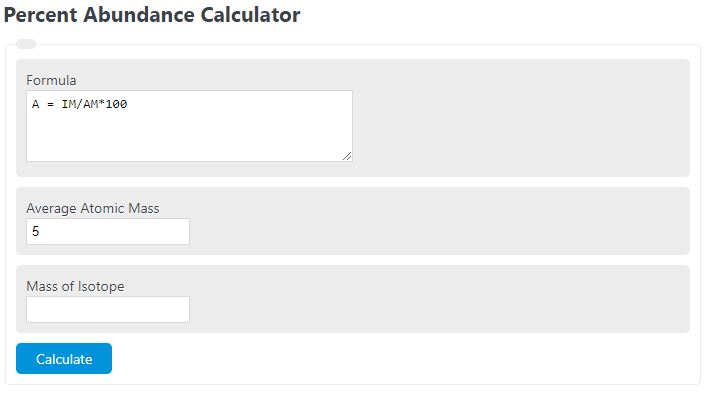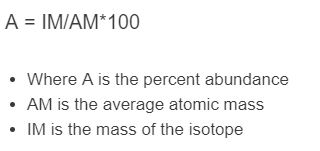Enter the average atomic mass of the substance and the mass of the isotope into the calculator to determine the percent abundance.
- Average Atomic Mass Calculator
- Mass Molarity Calculator
- Molarity Calculator
- Moisture Content Calculator
Percent Abundance Formula
The following formula is used to calculate the percent abundance of an isotope.
A = IM/AM*100
- Where A is the percent abundance
- AM is the average atomic mass
- IM is the mass of the isotope
Percent Abundance Definition
Percent abundance refers to the relative amount or proportion of a particular isotope within a sample of an element. Isotopes are atoms of the same element with different numbers of neutrons in their nuclei, resulting in different atomic masses. Since most elements have multiple isotopes, percent abundance helps in determining the average atomic mass of an element.
The atomic mass of an element is the weighted average of the masses of its isotopes, taking into account their percent abundances.
To calculate the average atomic mass, the mass of each isotope is multiplied by its percent abundance (expressed as a decimal), and the products are summed. This value is crucial in understanding the overall behavior and properties of elements.
Percent abundance is important as it provides valuable information about the isotopic composition of elements. It allows scientists to quantify the proportion of each isotope present in a sample, which has significant implications in various scientific fields.
For instance, in chemistry, percent abundance is crucial for accurate stoichiometric calculations, as different isotopes may have slightly different reactivity.
Percent Abundance Example
Example Problem 1:
First, determine the average atomic mass. For more information on calculating the average atomic mass of a substance, visit the calculator linked above.
For this example, the average atomic mass is found to be: 400.
Next, determine the mass of the isotope.
For this example, the isotope mass is found to be 200.
Finally, calculate the percent abundance using the formula above:
A = IM/AM*100
A = 200/400*100
A = 50%
FAQ
What is the significance of calculating percent abundance in chemistry?
Percent abundance plays a crucial role in determining the average atomic mass of elements, which is essential for accurate stoichiometric calculations in chemistry. It helps understand the isotopic composition of elements and their behavior during chemical reactions.
How does the number of neutrons affect isotopic mass and percent abundance?
Isotopes of an element have different numbers of neutrons, which changes their atomic mass but not their chemical properties. The variation in isotopic mass influences the calculation of percent abundance, as it affects the weighted average of an element’s atomic mass.
Can percent abundance be used to identify unknown substances?
Yes, by determining the percent abundances and average atomic masses of isotopes in a sample, scientists can identify unknown substances. This is because each element has a unique isotopic composition that serves as a “fingerprint”.
Why is the average atomic mass of an element not always a whole number?
The average atomic mass of an element is not always a whole number because it is a weighted average of the masses of all the isotopes of that element, considering their percent abundances. Since isotopes have different masses and are present in varying amounts, the average typically results in a decimal value.

